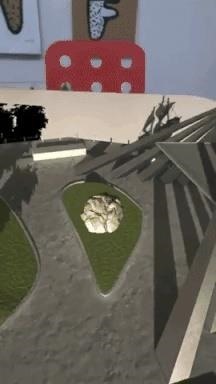There was a time when building a website required coding knowledge. Eventually, software came along that made the process easier, and then services like Squarespace made it dead simple for even a technical novice to design a website.
Now, with the content creation platform from Mirra, creating immersive augmented and virtual reality content may become as easy as putting together a PowerPoint presentation. Equipped with nothing more than a web browser, users can use the tool to build augmented and virtual reality scenes using a simple drag-and-drop interface.
"We don't know of anything that's quite this easy. You're two clicks away from being in a full-blown 3D editor," said Kevin Farnham, Mirra founder and CEO, in an interview with Next Reality. "So giving people a tool where they can create full-blown immersive experiences this simply I think is a cool achievement."

Last month, Mirra launched its web editor as a public beta, with a viewer app available on desktop, Oculus, and Vive. Support for Google Daydream View, Samsung Gear VR, and Windows Mixed Reality is coming soon.
By the end of the year, Mirra plans to release apps running on Apple's ARKit and Google's ARCore platforms for viewing AR content. Technically, the platform already supports the content, but they just need to build the app.
"In terms of going to different view outputs, whether that's VR, AR, MR, or whatever you want, we don't care and the content doesn't care," said Farnham. "It's basically just switching the camera view as far as we're concerned."
The initial version of the mobile app will enable creators to publish content from the online Mirra Editor and allow users to view the content. Version 1.0 of the app will offer three POV modes: diorama, for viewing content on a tabletop, immersive, to surround the user with virtual content and environments, and a content-only mode, to view content in a user's real-world environment. Through the usual multi-touch gestures, users will be able to interact with content, trigger actions, and move objects.
In version 1.5 of the app, slated for release in early 2018, the company hopes to add support for QR code and image recognition scanning to share and launch AR experiences as well as geotagging for location-based discovery.


The web-based editor is a JavaScript layer over WebGL with a node backend. To make it work, Mirra uses highly-compressed digital environments. As a result, some features in editing mode, such as videos placed in a scene, are not viewable; however, once they are rendered in the viewer, everything works as intended.
For a web-based editor, Mirra is packed with features. An array of about two dozen hotkeys give users ample control over the environment, viewpoints, and objects. Users can place images, video, audio, 360-degree images and video, and 3D models into environments, and they can specify positions and actions for each item within a scene.
"We're really trying to push a level of ease that's unusual here," said Farnham. "We were modeling after Squarespace and Keynote and things like that, where it's drag-and-drop simple all the way through."
Farnham expects that users will be able to pull in assets from 3D content libraries like Sketchfab and Google's new Poly service.
"We could not be more excited about Poly. All their models work flawlessly in our system," said Farnham. "Short of pervasive use of GL transmission format (glTF), it's a match made in heaven for us and our creators."



The process is so simple that Farnham envisions people being able to create AR experiences for everything from business presentations to family sharing. For example, he has discussed a use case with one customer who wants to map out his family's history, placing geofenced AR content in the places where past events have occurred.
We believe it's the future of 3D content creation and publishing because we make it dead simple for anyone to create in this next frontier. We think that it's similar to what Squarespace did to make publishing new, beautiful websites simple or what Photoshop did to make graphic design easier.
Prior to Mirra, Farnham ran a design firm called Method, which he started in 1998 and sold in 2008, remaining with the company as an executive until 2014. During his tenure there, the firm served several high-profile clients. For Google, the firm worked on branding for Google Wallet and Google Fiber. For the BBC, Method helped launch the BBC Player app.
With the proceeds from the sale of Method, Farnham funded the launch of Mirra. The company has operated in stealth mode until the recent launch of its public beta.
"I'm super excited about where we're going with the AR thing," said Farnham. "At least to date, we haven't seen anybody [providing this kind of] functionality. "
Update: Thursday, Feb. 1: Mirra has just announced the release of its Mirra-AR app for iOS. The tool is designed to allow users to view the AR content created with Mirra software. "With our new AR app, you can see experiences as if they were right in front of you or you might choose to immerse yourself in the content," said Kevin Farnham, CEO of Mirra, in a statement. "Even experiences intended for VR are viewable without the need for a headset."

Just updated your iPhone? You'll find new features for Podcasts, News, Books, and TV, as well as important security improvements and fresh wallpapers. Find out what's new and changed on your iPhone with the iOS 17.5 update.

























Be the First to Comment
Share Your Thoughts